tire size TOYOTA RAV4 HYBRID 2020 Warranties & Maintenance Guides (in English)
[x] Cancel search | Manufacturer: TOYOTA, Model Year: 2020, Model line: RAV4 HYBRID, Model: TOYOTA RAV4 HYBRID 2020Pages: 260, PDF Size: 8.54 MB
Page 199 of 260
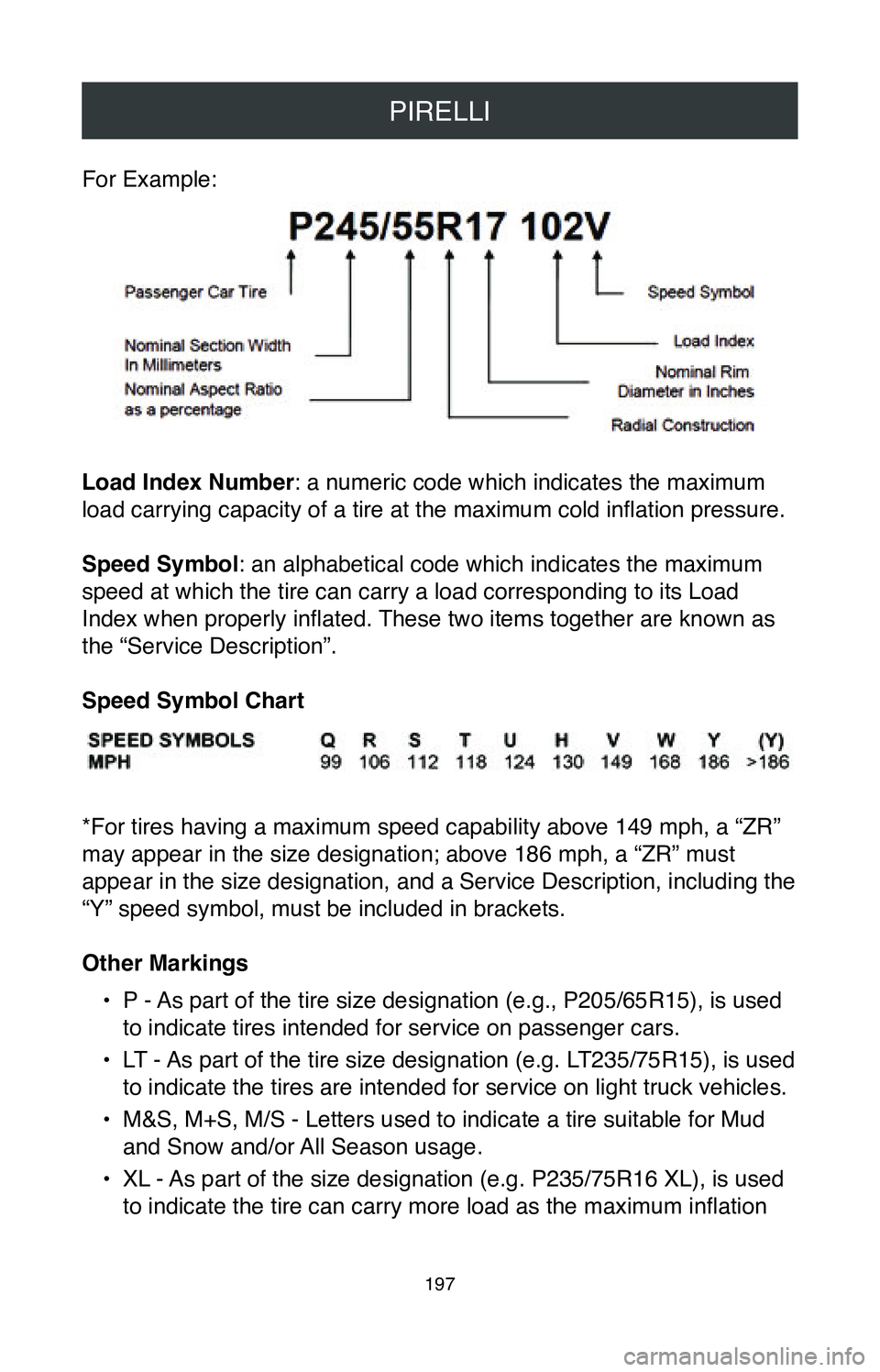
PIRELLI
197
For Example:
Load Index Number: a numeric code which indicates the maximum
load carrying capacity of a tire at the maximum cold inflation pressure.
Speed Symbol: an alphabetical code which indicates the maximum
speed at which the tire can carry a load corresponding to its Load
Index when properly inflated. These two items together are known as
the “Service Description”.
Speed Symbol Chart
*For tires having a maximum speed capability above 149 mph, a “ZR”
may appear in the size designation; above 186 mph, a “ZR” must
appear in the size designation, and a Service Description, including the\
“Y” speed symbol, must be included in brackets.
Other Markings
•
P - As part of the tire size designation (e.g., P205/65R15), is used
to indicate tires intended for service on passenger cars.
•
LT - As part of the tire size designation (e.g. LT235/75R15), is used
to indicate the tires are intended for service on light truck vehicles.
•
M&S, M+S, M/S - Letters used to indicate a tire suitable for Mud
and Snow and/or All Season usage.
•
XL - As part of the size designation (e.g. P235/75R16 XL), is used
to indicate the tire can carry more load as the maximum inflation
Page 202 of 260
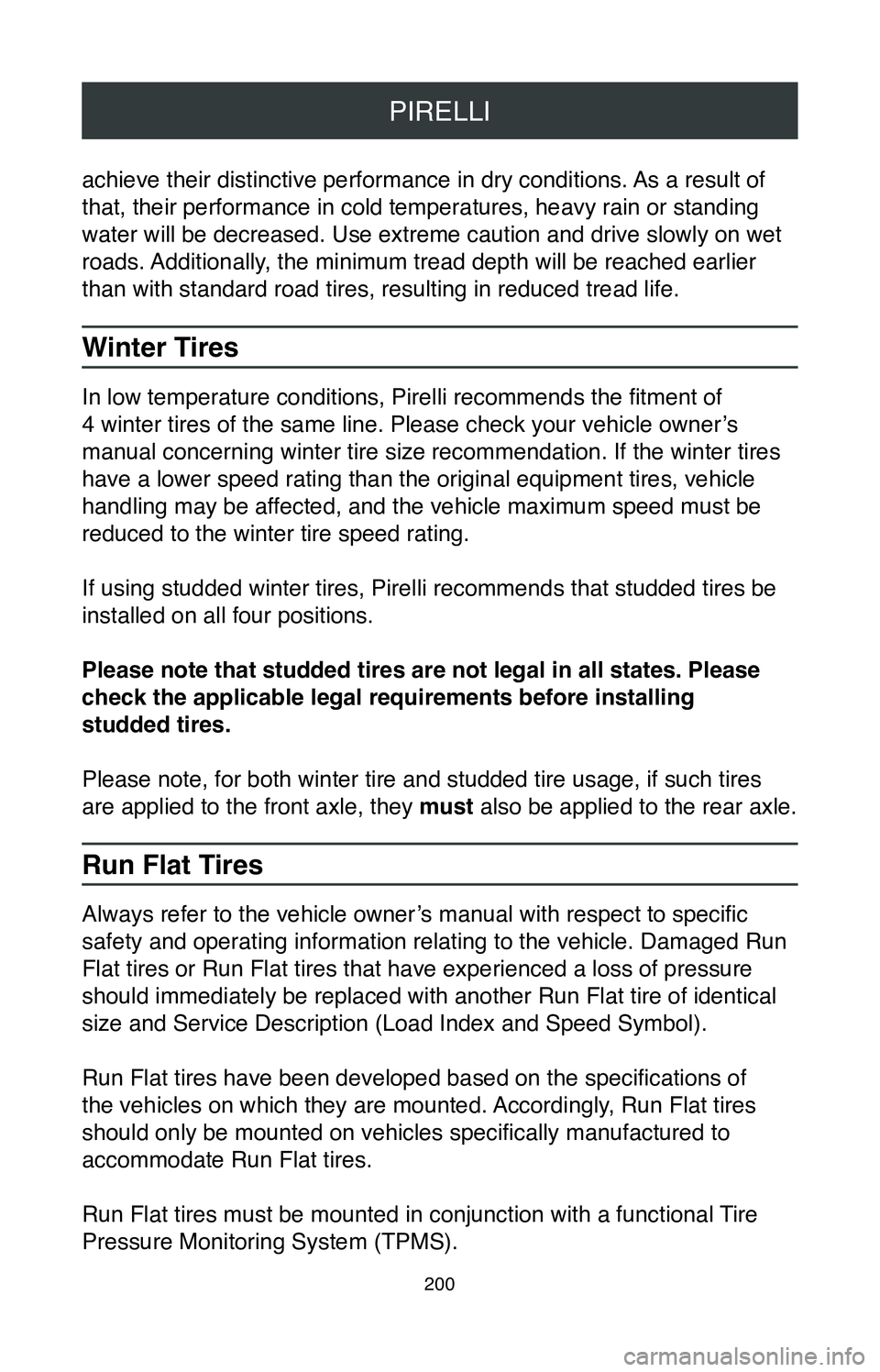
PIRELLI
200
achieve their distinctive performance in dry conditions. As a result of
that, their performance in cold temperatures, heavy rain or standing
water will be decreased. Use extreme caution and drive slowly on wet
roads. Additionally, the minimum tread depth will be reached earlier
than with standard road tires, resulting in reduced tread life.
Winter Tires
In low temperature conditions, Pirelli recommends the fitment of
4 winter tires of the same line. Please check your vehicle owner’s
manual concerning winter tire size recommendation. If the winter tires
have a lower speed rating than the original equipment tires, vehicle
handling may be affected, and the vehicle maximum speed must be
reduced to the winter tire speed rating.
If using studded winter tires, Pirelli recommends that studded tires be \
installed on all four positions.
Please note that studded tires are not legal in all states. Please
check the applicable legal requirements before installing
studded tires.
Please note, for both winter tire and studded tire usage, if such tires \
are applied to the front axle, they must also be applied to the rear axle.
Run Flat Tires
Always refer to the vehicle owner’s manual with respect to specific
safety and operating information relating to the vehicle. Damaged Run
Flat tires or Run Flat tires that have experienced a loss of pressure
should immediately be replaced with another Run Flat tire of identical
size and Service Description (Load Index and Speed Symbol).
Run Flat tires have been developed based on the specifications of
the vehicles on which they are mounted. Accordingly, Run Flat tires
should only be mounted on vehicles specifically manufactured to
accommodate Run Flat tires.
Run Flat tires must be mounted in conjunction with a functional Tire
Pressure Monitoring System (TPMS).
Page 203 of 260
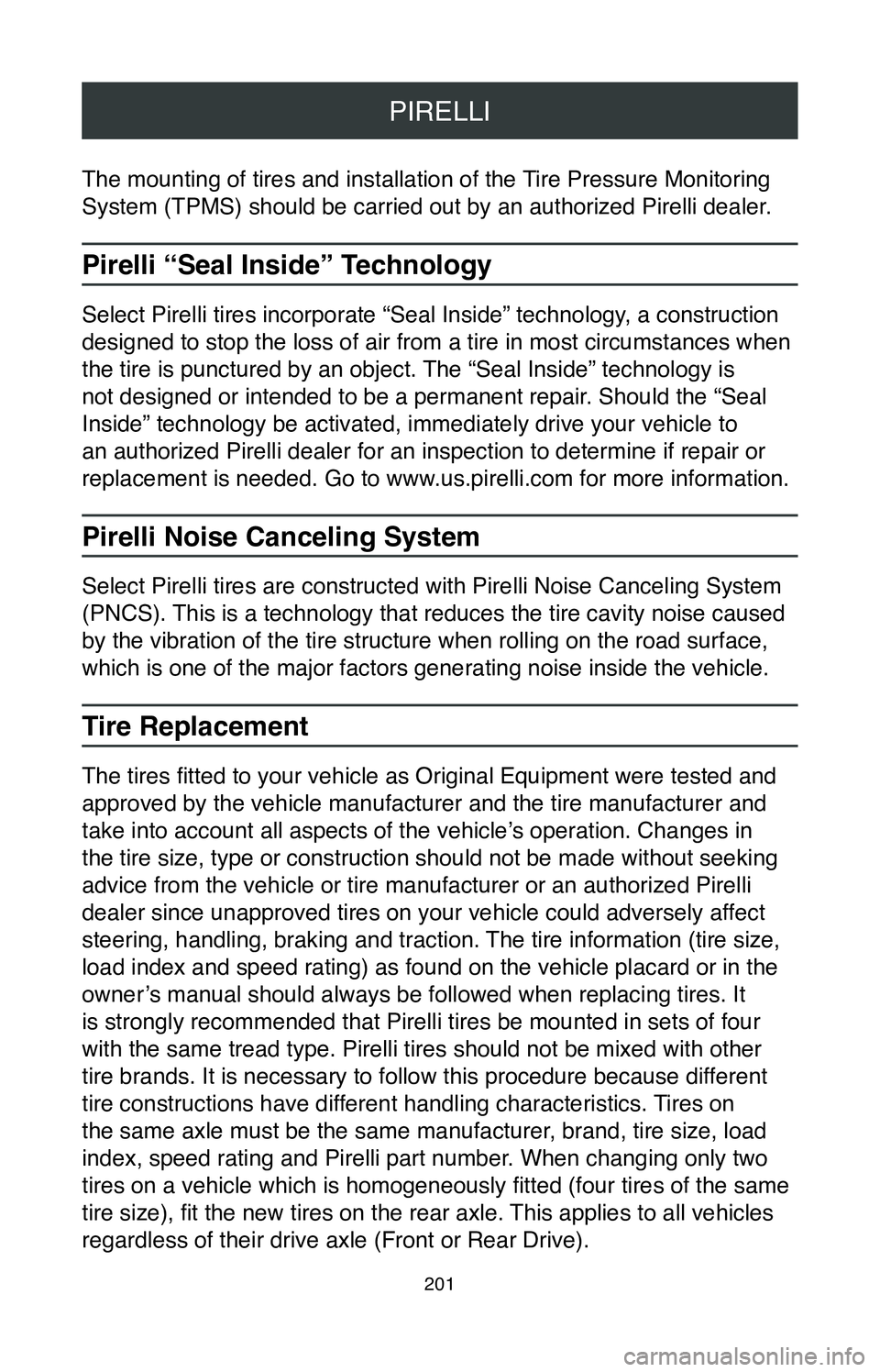
PIRELLI
201
The mounting of tires and installation of the Tire Pressure Monitoring
System (TPMS) should be carried out by an authorized Pirelli dealer.
Pirelli “Seal Inside” Technology
Select Pirelli tires incorporate “Seal Inside” technology, a construction
designed to stop the loss of air from a tire in most circumstances when \
the tire is punctured by an object. The “Seal Inside” technology is
not designed or intended to be a permanent repair. Should the “Seal
Inside” technology be activated, immediately drive your vehicle to
an authorized Pirelli dealer for an inspection to determine if repair or\
replacement is needed. Go to www.us.pirelli.com for more information.
Pirelli Noise Canceling System
Select Pirelli tires are constructed with Pirelli Noise Canceling System\
(PNCS). This is a technology that reduces the tire cavity noise caused
by the vibration of the tire structure when rolling on the road surface,\
which is one of the major factors generating noise inside the vehicle.
Tire Replacement
The tires fitted to your vehicle as Original Equipment were tested and
approved by the vehicle manufacturer and the tire manufacturer and
take into account all aspects of the vehicle’s operation. Changes in
the tire size, type or construction should not be made without seeking
advice from the vehicle or tire manufacturer or an authorized Pirelli
dealer since unapproved tires on your vehicle could adversely affect
steering, handling, braking and traction. The tire information (tire size,
load index and speed rating) as found on the vehicle placard or in the \
owner’s manual should always be followed when replacing tires. It
is strongly recommended that Pirelli tires be mounted in sets of four
with the same tread type. Pirelli tires should not be mixed with other
tire brands. It is necessary to follow this procedure because different
tire constructions have different handling characteristics. Tires on
the same axle must be the same manufacturer, brand, tire size, load
index, speed rating and Pirelli part number. When changing only two
tires on a vehicle which is homogeneously fitted (four tires of the same
tire size), fit the new tires on the rear axle. This applies to all vehicles
regardless of their drive axle (Front or Rear Drive).
Page 204 of 260
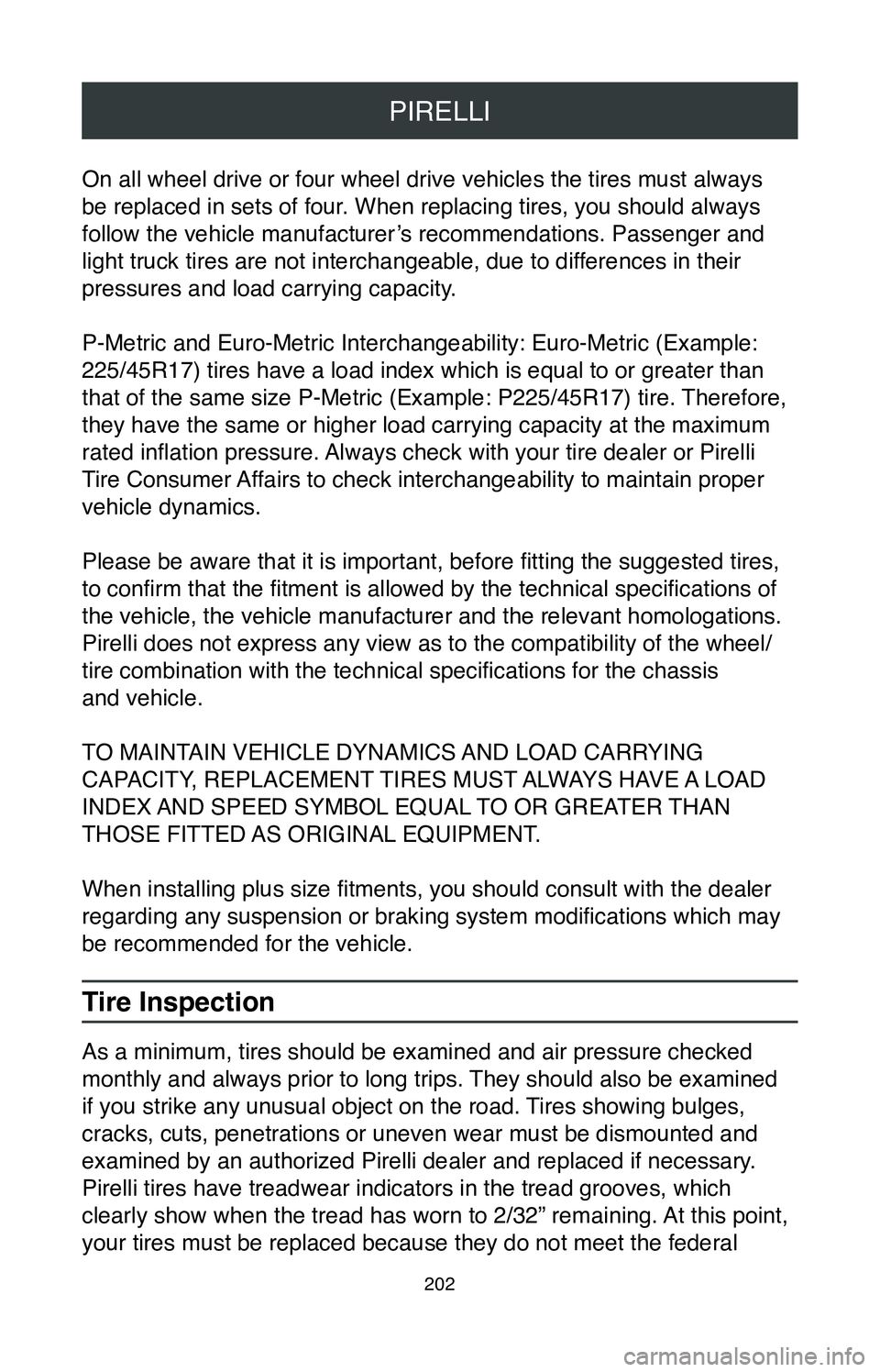
PIRELLI
202
On all wheel drive or four wheel drive vehicles the tires must always
be replaced in sets of four. When replacing tires, you should always
follow the vehicle manufacturer’s recommendations. Passenger and
light truck tires are not interchangeable, due to differences in their
pressures and load carrying capacity.
P-Metric and Euro-Metric Interchangeability: Euro-Metric (Example:
225/45R17) tires have a load index which is equal to or greater than
that of the same size P-Metric (Example: P225/45R17) tire. Therefore,
they have the same or higher load carrying capacity at the maximum
rated inflation pressure. Always check with your tire dealer or Pirelli
Tire Consumer Affairs to check interchangeability to maintain proper
vehicle dynamics.
Please be aware that it is important, before fitting the suggested tires,
to confirm that the fitment is allowed by the technical specifications of
the vehicle, the vehicle manufacturer and the relevant homologations.
Pirelli does not express any view as to the compatibility of the wheel/
tire combination with the technical specifications for the chassis
and vehicle.
TO MAINTAIN VEHICLE DYNAMICS AND LOAD CARRYING
CAPACITY, REPLACEMENT TIRES MUST ALWAYS HAVE A LOAD
INDEX AND SPEED SYMBOL EQUAL TO OR GREATER THAN
THOSE FITTED AS ORIGINAL EQUIPMENT.
When installing plus size fitments, you should consult with the dealer
regarding any suspension or braking system modifications which may
be recommended for the vehicle.
Tire Inspection
As a minimum, tires should be examined and air pressure checked
monthly and always prior to long trips. They should also be examined
if you strike any unusual object on the road. Tires showing bulges,
cracks, cuts, penetrations or uneven wear must be dismounted and
examined by an authorized Pirelli dealer and replaced if necessary.
Pirelli tires have treadwear indicators in the tread grooves, which
clearly show when the tread has worn to 2/32” remaining. At this point,
your tires must be replaced because they do not meet the federal
Page 210 of 260
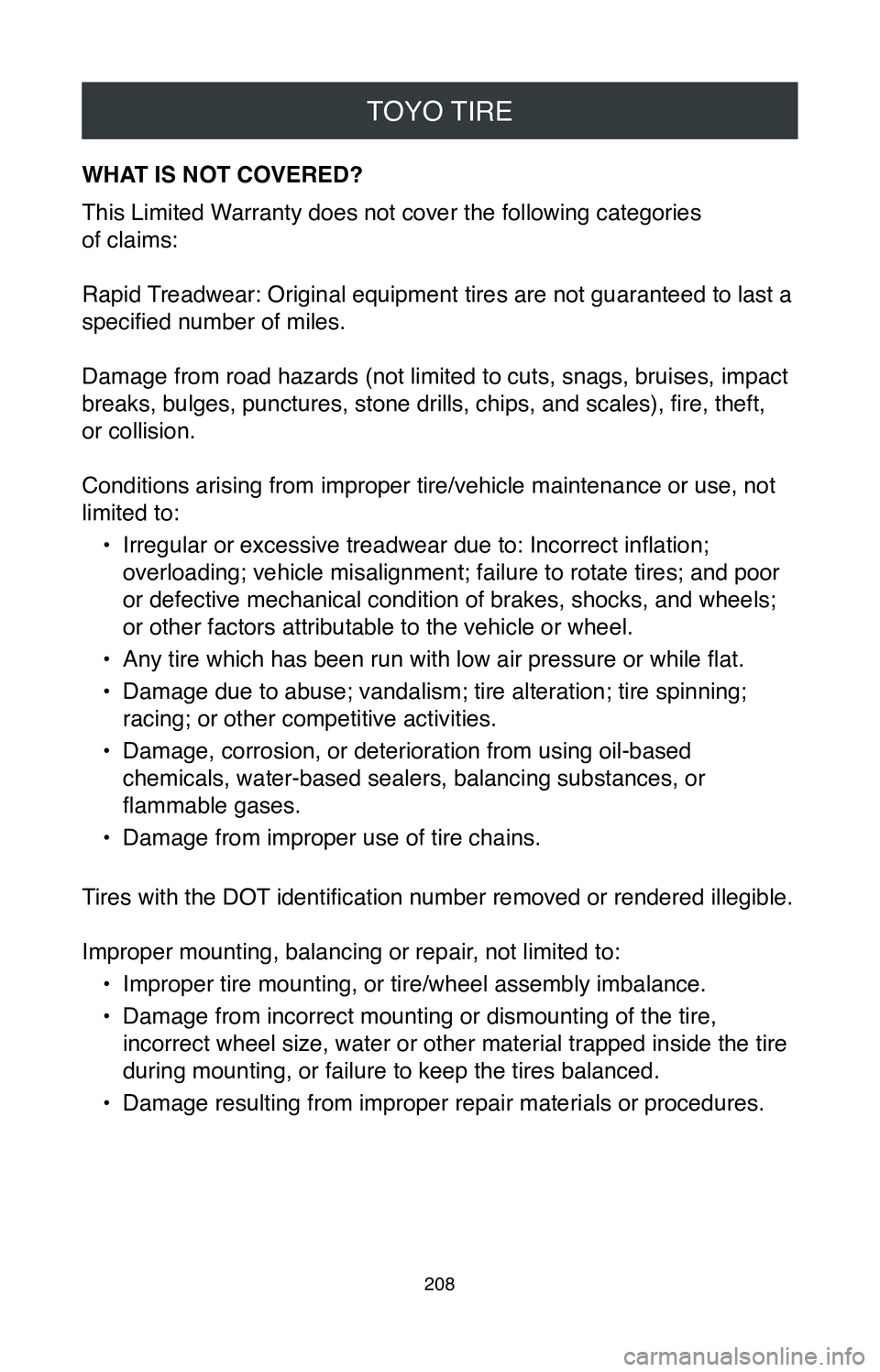
TOYO TIRE
208
WHAT IS NOT COVERED?
This Limited Warranty does not cover the following categories
of claims:
Rapid Treadwear: Original equipment tires are not guaranteed to last a
specified number of miles.
Damage from road hazards (not limited to cuts, snags, bruises, impact
breaks, bulges, punctures, stone drills, chips, and scales), fire, theft,
or collision.
Conditions arising from improper tire/vehicle maintenance or use, not
limited to:
•
Irregular or excessive treadwear due to: Incorrect inflation;
overloading; vehicle misalignment; failure to rotate tires; and poor
or defective mechanical condition of brakes, shocks, and wheels;
or other factors attributable to the vehicle or wheel.
•
Any tire which has been run with low air pressure or while flat.
•
Damage due to abuse; vandalism; tire alteration; tire spinning;
racing; or other competitive activities.
•
Damage, corrosion, or deterioration from using oil-based
chemicals, water-based sealers, balancing substances, or
flammable gases.
•
Damage from improper use of tire chains.
Tires with the DOT identification number removed or rendered illegible.
Improper mounting, balancing or repair, not limited to: •
Improper tire mounting, or tire/wheel assembly imbalance.
•
Damage from incorrect mounting or dismounting of the tire,
incorrect wheel size, water or other material trapped inside the tire
during mounting, or failure to keep the tires balanced.
•
Damage resulting from improper repair materials or procedures.
Page 223 of 260
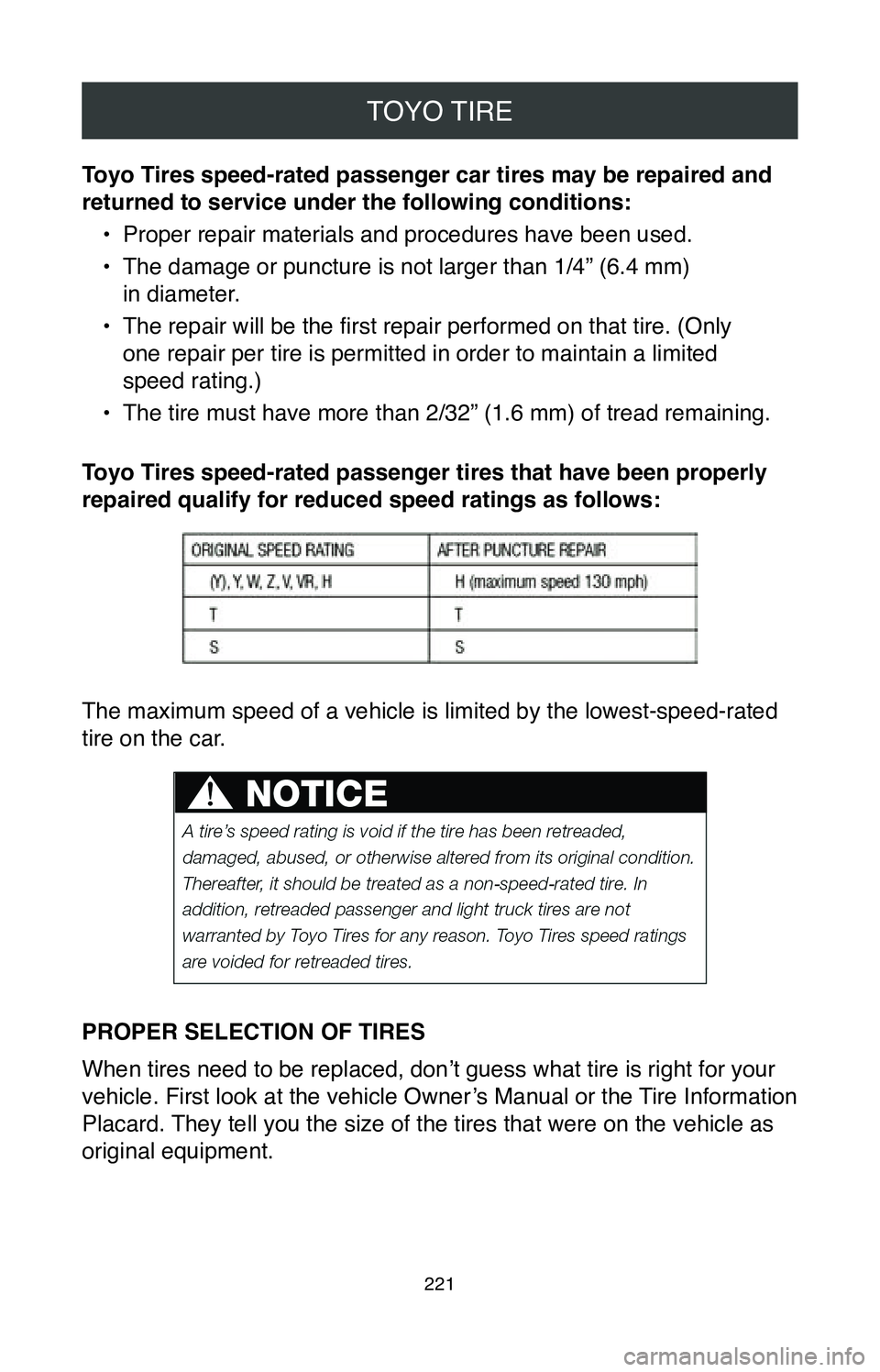
TOYO TIRE
221
Toyo Tires speed-rated passenger car tires may be repaired and
returned to service under the following conditions:•
Proper repair materials and procedures have been used.
•
The damage or puncture is not larger than 1/4” (6.4 mm)
in diameter.
•
The repair will be the first repair performed on that tire. (Only
one repair per tire is permitted in order to maintain a limited
speed rating.)
•
The tire must have more than 2/32” (1.6 mm) of tread remaining.
Toyo Tires speed-rated passenger tires that have been properly
repaired qualify for reduced speed ratings as follows:
The maximum speed of a vehicle is limited by the lowest-speed-rated
tire on the car.
PROPER SELECTION OF TIRES
When tires need to be replaced, don’t guess what tire is right for your
vehicle. First look at the vehicle Owner’s Manual or the Tire Information
Placard. They tell you the size of the tires that were on the vehicle as
original equipment.
Page 224 of 260
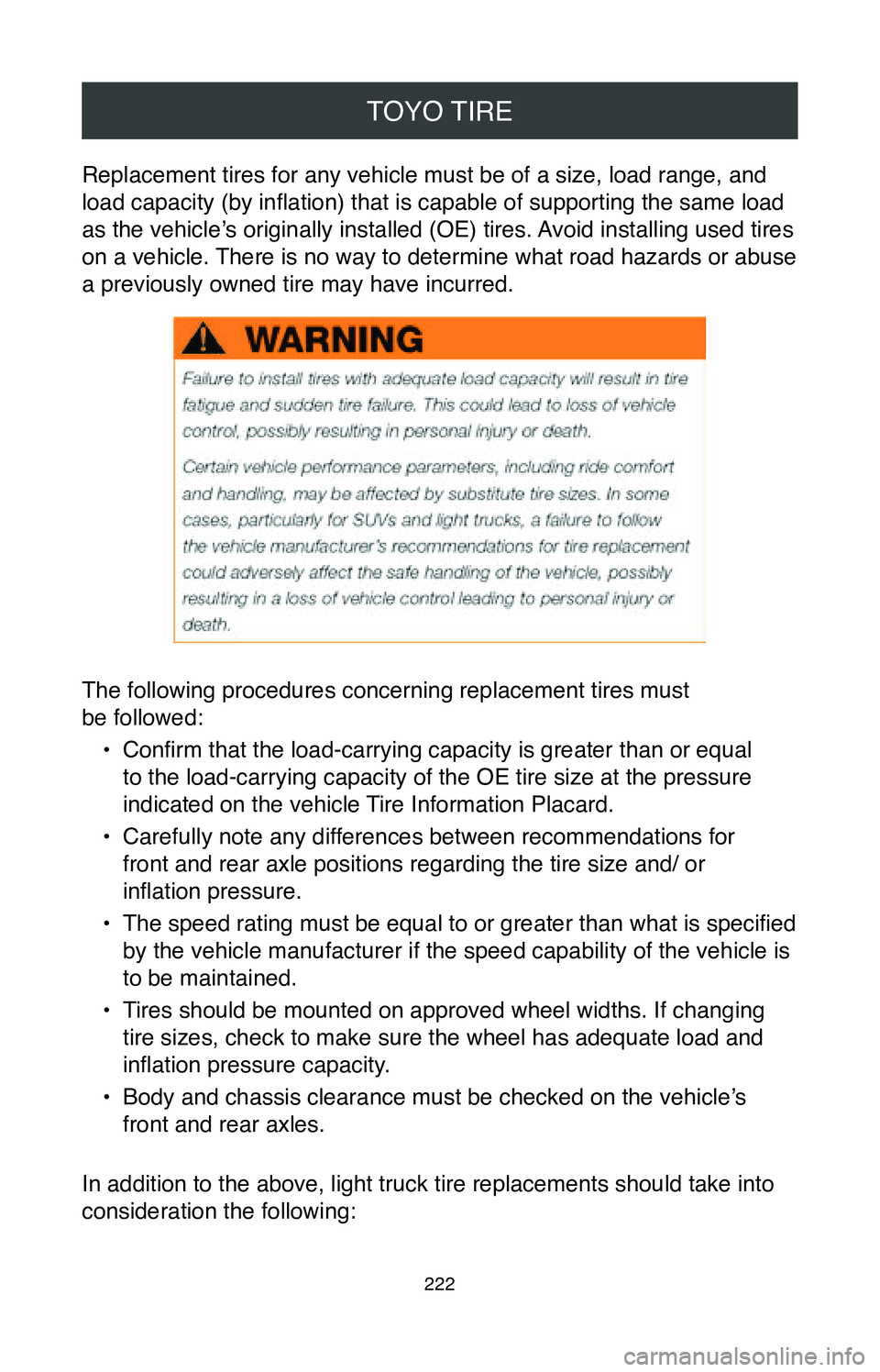
TOYO TIRE
222
Replacement tires for any vehicle must be of a size, load range, and
load capacity (by inflation) that is capable of supporting the same load
as the vehicle’s originally installed (OE) tires. Avoid installing used tires
on a vehicle. There is no way to determine what road hazards or abuse
a previously owned tire may have incurred.
The following procedures concerning replacement tires must
be followed:•
Confirm that the load-carrying capacity is greater than or equal
to the load-carrying capacity of the OE tire size at the pressure
indicated on the vehicle Tire Information Placard.
•
Carefully note any differences between recommendations for
front and rear axle positions regarding the tire size and/ or
inflation pressure.
•
The speed rating must be equal to or greater than what is specified
by the vehicle manufacturer if the speed capability of the vehicle is
to be maintained.
•
Tires should be mounted on approved wheel widths. If changing
tire sizes, check to make sure the wheel has adequate load and
inflation pressure capacity.
•
Body and chassis clearance must be checked on the vehicle’s
front and rear axles.
In addition to the above, light truck tire replacements should take into\
consideration the following:
Page 225 of 260
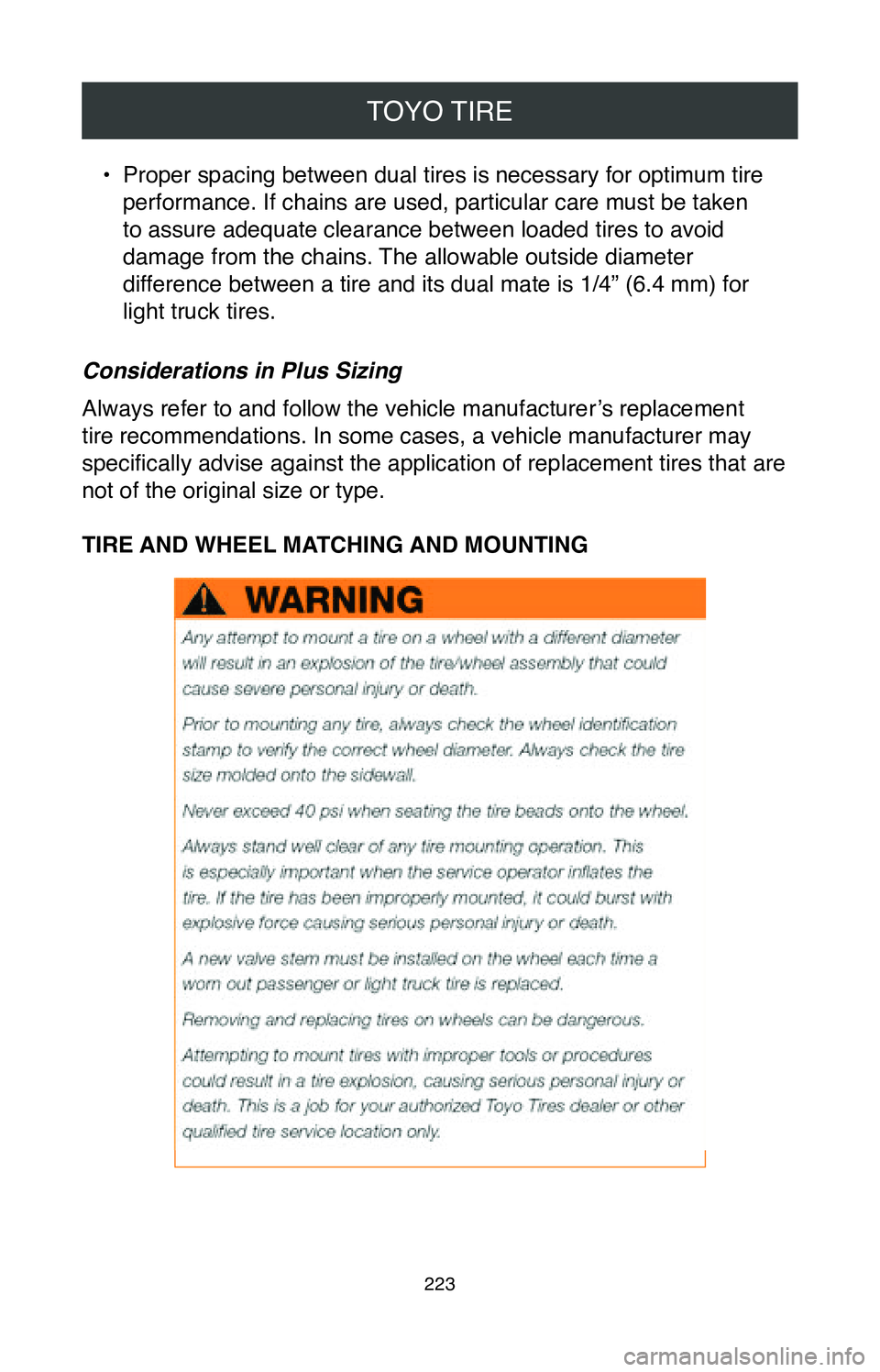
TOYO TIRE
223
• Proper spacing between dual tires is necessary for optimum tire
performance. If chains are used, particular care must be taken
to assure adequate clearance between loaded tires to avoid
damage from the chains. The allowable outside diameter
difference between a tire and its dual mate is 1/4” (6.4 mm) for
light truck tires.
Considerations in Plus Sizing
Always refer to and follow the vehicle manufacturer’s replacement
tire recommendations. In some cases, a vehicle manufacturer may
specifically advise against the application of replacement tires that are
not of the original size or type.
TIRE AND WHEEL MATCHING AND MOUNTING
Page 226 of 260
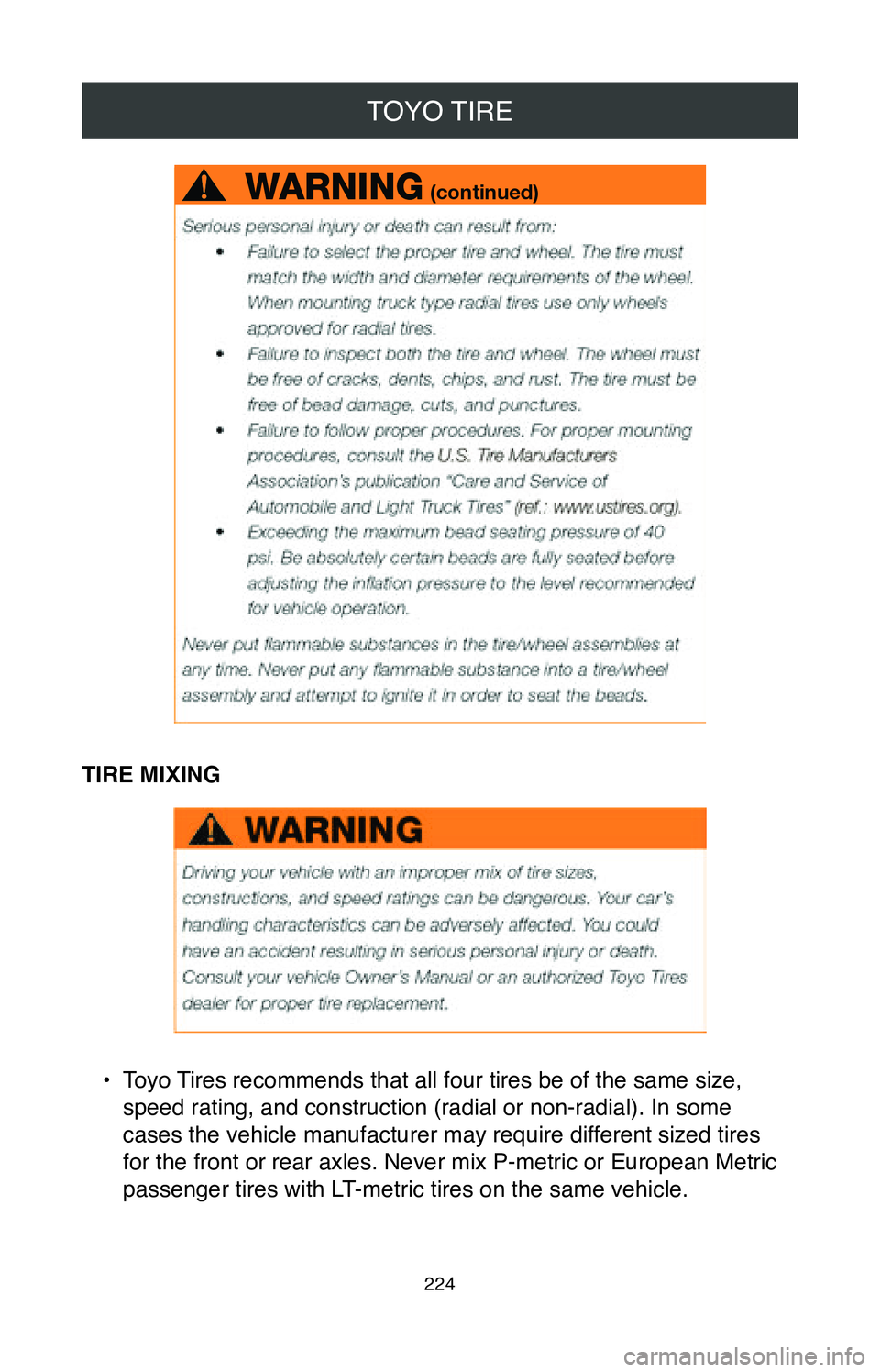
TOYO TIRE
224
TIRE MIXING
• Toyo Tires recommends that all four tires be of the same size,
speed rating, and construction (radial or non-radial). In some
cases the vehicle manufacturer may require different sized tires
for the front or rear axles. Never mix P-metric or European Metric
passenger tires with LT-metric tires on the same vehicle.
Page 227 of 260
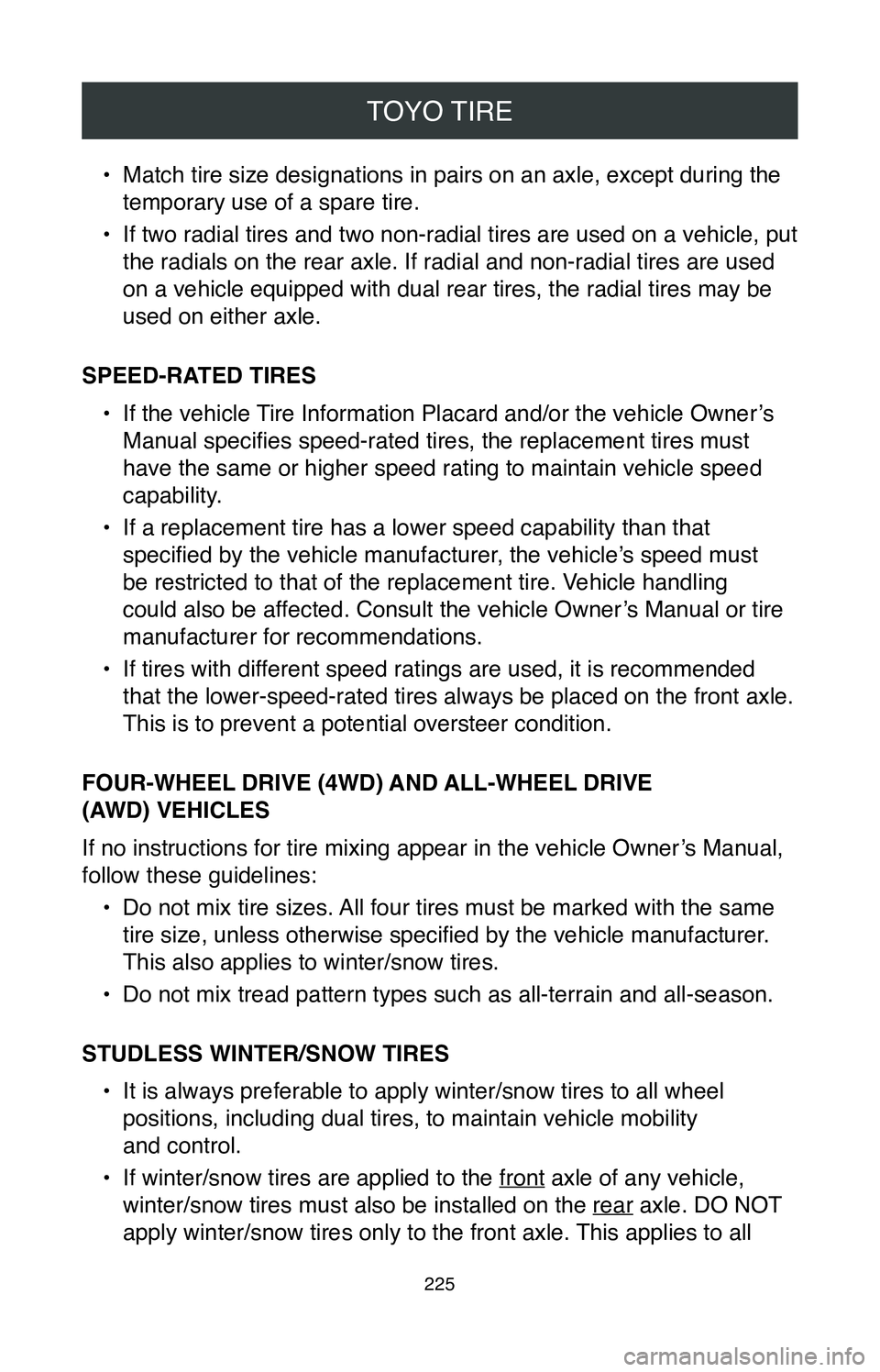
TOYO TIRE
225
• Match tire size designations in pairs on an axle, except during the
temporary use of a spare tire.
•
If two radial tires and two non-radial tires are used on a vehicle, put
the radials on the rear axle. If radial and non-radial tires are used
on a vehicle equipped with dual rear tires, the radial tires may be
used on either axle.
SPEED-RATED TIRES •
If the vehicle Tire Information Placard and/or the vehicle Owner’s
Manual specifies speed-rated tires, the replacement tires must
have the same or higher speed rating to maintain vehicle speed
capability.
•
If a replacement tire has a lower speed capability than that
specified by the vehicle manufacturer, the vehicle’s speed must
be restricted to that of the replacement tire. Vehicle handling
could also be affected. Consult the vehicle Owner’s Manual or tire
manufacturer for recommendations.
•
If tires with different speed ratings are used, it is recommended
that the lower-speed-rated tires always be placed on the front axle.
This is to prevent a potential oversteer condition.
FOUR-WHEEL DRIVE (4WD) AND ALL-WHEEL DRIVE
(AWD) VEHICLES
If no instructions for tire mixing appear in the vehicle Owner’s Manual,
follow these guidelines: •
Do not mix tire sizes. All four tires must be marked with the same
tire size, unless otherwise specified by the vehicle manufacturer .
This also applies to winter/snow tires.
•
Do not mix tread pattern types such as all-terrain and all-season.
STUDLESS WINTER/SNOW TIRES •
It is always preferable to apply winter/snow tires to all wheel
positions, including dual tires, to maintain vehicle mobility
and control.
•
If winter/snow tires are applied to the front axle of any vehicle,
winter/snow tires must also be installed on the rear axle. DO NOT
apply winter/snow tires only to the front axle. This applies to all